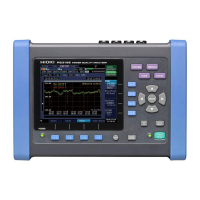A25
Appendix
Appendix 9 Terminology
EN50160
A European power supply quality standard that defines limit values for supply voltage and
other characteristics. The PQ ONE application software can be used with data from the
PQ3198 to perform standard-compliant evaluation and analysis.
IEC61000-4-7
An international standard governing measurement of harmonic current and harmonic volt-
age in power supply systems as well as harmonic current emitted by equipment.
The stan-
dard specifies the performance
of a standard instrument.
IEC61000-4-15
A standard that defines testing techniques for voltage fluctuation and flicker measurement
as well as associated measuring instrument requirements.
IEC61000-4-30
A standard governing testing involving power quality measurement in AC power supply
systems and associated measurement technologies. Target parameters are restricted to
phenomena that are propagated in power systems, specifically frequency, supply voltage
amplitude (RMS), flicker, supply voltage dips, swells, (momentary) interruptions, transient
overvoltages, supply voltage unbalance, harmonics, inter-harmonics, supply voltage car-
rier signals, and high-speed voltage variations.
The standard defines measurement methods for
these parameters as well as the neces-
sary instrument performance. It does not define specific thresholds.
Measurement classes
The standard defines three classes (A, S, and B) for various instrument measuring meth-
ods and measurement performance levels:
ITIC curve
A graph created by the Information Technology Industry Council plotting voltage distur-
bance data for detected events using the event duration and worst value (as a percentage
o
f the nominal input voltage). The graph format makes it easy to quickly identify which
event data distribution should be analyzed. The PQ ONE application software can be used
to create ITIC curves using PQ3198 data.
K factor
Shows the power loss caused by the harmonic current in transformers.
Also referred to as the "multiplication factor."
The K factor (KF) is formulated as shown
below:
k: Order of harmonics
Ik: Ratio of the harmonic current to the fundamental wave current [%]
Higher-order harmonic currents have a greater influence on the K factor than lower-order
harmonic currents.
Purpose of measurement
To measure the K factor in a transformer when subjected to maximum load. If the mea-
sured K factor is larger than the multiplication
factor of the transformer used, the trans-
former must be replaced with one with a larger K facto
r, or the load on the transformer
must be reduced. The replacement transformer should have a K factor one rank higher
than the measured K factor for the transformer being replaced.
Class Applications
Class A
Used in applications where accurate measurement is required, for
example verification of standard compliance and dispute settlement.
In order to ensure accurate measurement, the standard includes
detailed stipulations concerning instrument time clock accuracy, RMS
value calculation methods, and TIME PLOT data grouping.
Class S Used in surveys and power supply quality evaluation.
Class B
Used in applications where a high level of accuracy is not required,
for example troubleshooting.
KF
k
2
I
k
×
2
k
1=
50
I
k
2
k
1=
50
----------------------------------=

